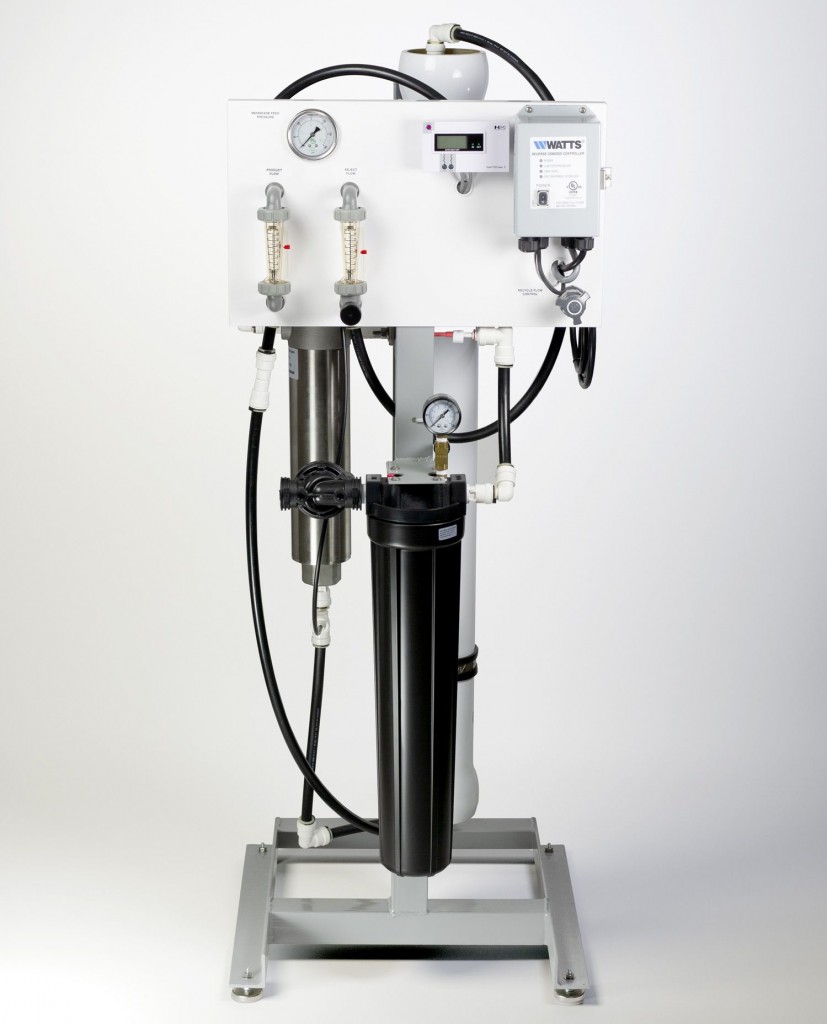Whole House Reverse Osmosis
The most common reason for buying a whole house reverse osmosis unit for a residential well is to treat water with such high salt content that it is otherwise essentially unusable. RO is the only practical way for residential users to remove large amounts of minerals like sodium and chloride from well water.
For most other problem contaminants with wells, like hardness, iron, and manganese, there are easier ways than reverse osmosis, and some contaminants, like arsenic and nitrates, which are removed well by RO, are most often addressed as drinking water but not whole house treatment problems.
Before and After Test Results for a Whole House RO Unit
Below is a chart showing before treatment and after treatment results from National Test Labs tests made by one of our customers. The high TDS (Total Dissolved Solids) water is treated with a sediment filter, a water softener (to protect the reverse osmosis unit), then with a Watts R12 1200 GPD RO unit. This water is typical of what whole house residential reverse osmosis is used for–bringing the TDS count down to a level where the water is usable for household purposes. I’ve selected a few items from the tests that illustrate typical RO performance on high TDS well water.
|
Contaminant or Characteristic |
Untreated |
Treated |
% Reduction |
| Lithium |
0.352 ppm |
0.007 ppm |
98% |
| Silica |
12.5 ppm |
0.7 ppm |
94% |
| Sodium |
761 ppm |
15 ppm |
98% |
| Hardness |
260 ppm |
0 ppm |
100% |
| pH |
7.6 |
5.7 |
NA (See comment below.) |
| TDS |
2400 ppm |
84 ppm |
97% |
| Chloride |
310 ppm |
17 ppm |
95% |
| Fluoride |
3.6 ppm |
0 ppm |
100% |
| Nitrate |
2.2 ppm |
0.6 ppm |
72% |
| Sulfate |
960 ppm |
0 ppm |
100% |
A whole house reverse osmosis system consists of a lot more than the reverse osmosis unit itself. In most cases the water will need pretreatent for sediment, hardness, iron, and manganese to protect the RO membrane(s).
Most large RO units produce water into a non-pressurized tank, so a pump will be needed to send the water to the home. RO lowers the pH of the water (see test results above), so a neutralizing filter is usually added after the RO unit to to protect the home’s pipes and appliances from acidic water. An ultraviolet unit is usually added as the final stage to assure that the water is microbiologically safe.
You can normally expect the cost of pre-treatment, storage, delivery to the home, and post-treatment to be as much as the cost of the RO unit itself.
Whole house RO units are not trouble free. They require some attention, especially if pre-treatment equipment is used. One issue that people often overlook is that a lot of wastewater is generated and this has to be disposed of. Expect at least half the water that goes into the unit to come out as reject water, or brine, so if your family uses 300 gallons of water per day, you will have at least 300 gallons of reject water to get rid of. Disposal in rural environments can often be arranged so that septic systems are not overwhelmed. The homeowner who sent us his test results catches the RO brine in large holding tanks and blends it with rainwater to produce water suitable for irrigation.
Above is a 2200 gallon per day Watts R4X40 reverse osmosis unit. We offer Watts units that produce 600, 1200, 2200, 4400, and 6600 gallons per day. The unit shown includes low pressure cutoff to protect the unit if inlet pressure falls too low, pump to send pressurized water to the membrane, flow meters to measure both the permeate (product water) and brine (reject water) as they leave the membrane, a TDS meter to give instant TDS readings for both the untreated water and the permeate, and a manual control to allow part of the brine to be recycled for treatment.





